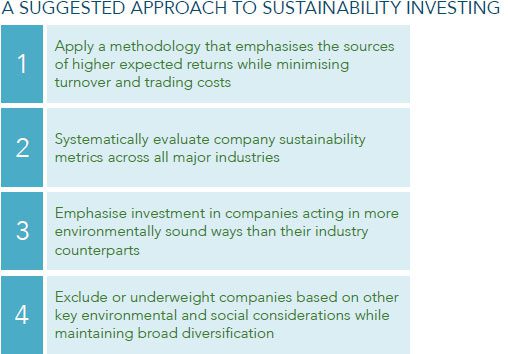The idea of ‘responsible investment’ seems to be catching on in Australia, with a global sustainable investment group that covers Australia, New Zealand and other developed nations, reporting that assets managed under responsible investment strategies increased by 25% between 2014-16 to $US22.89 trillion.1
Responsible investment is defined by the UN as an approach that aims to incorporate investors’ preferences around environmental, social and governance (ESG) factors into their investment portfolios.
As citizens, we can express our political preferences around sustainability through the ballot box, however, many people don’t feel that’s enough. So for those who want to do more, there’s an opportunity for investors to express their preferences through their investment portfolio via sustainable investing. The key question is how can we do this without compromising our desired investment outcomes?
For instance, how can I reduce the carbon footprint of my portfolio while maintaining sufficient diversification to meet my investment objectives?
It’s important to remember that sustainable investment preferences are not restricted to greenhouse gas emissions. Many people also have concerns about land use and biodiversity, toxic spills, operational waste and waste management.
Then there’s social responsibility.
Many investors want to exclude companies strongly associated with undesirable social issues such as tobacco, alcohol, gambling, pornography, child labour, factory farming, nuclear weapons, and cluster munitions and landmines. So, there’s a double challenge of efficiently taking into account sustainability and social considerations while building a robust investment solution to grow savings for our future needs.
A solution is to focus first on developing an investment methodology that emphasises the sources of higher expected returns while minimising turnover and trading costs. Once this framework is in place, we can get to work on the other part.
That second phase starts with evaluating companies on a broad array of sustainability measures across all industries. That means looking at companies across the whole portfolio and within individual sectors, with a view to both incorporating sustainable investing preferences while maintaining as much of the characteristics of the original strategy as possible.
Within each industry, the least sustainable companies are excluded, while the rest are overweighted or underweighted based on how well they rank among their industry peers. By using this scoring system, rather than an in-or-out screening process, we can preserve diversification and encourage good behaviour.

Taking this combined industry and portfolio approach allows for a dramatic reduction in carbon emissions–an important goal for many investors–while maintaining diversification and the focus on the drivers of expected returns.
With social screens, we can take more of a black-and-white approach where companies that draw significant revenues from tobacco, gambling or one of the other anti-social activities can be excluded altogether.
Importantly, this process of screening and exclusion can be applied to the fixed interest component of a portfolio as well as to the share portfolio.
Sustainable investing principles and approach are broadly the same
In Australia, we need to be mindful of the impact of sustainability and social screens in markets that by world standards, is small and very concentrated on a small number of very large companies.
For instance, excluding carbon-intensive energy, materials and utility stocks from an Australian share portfolio over the 28 years from 1990 would have led to a portfolio that looked significantly different to the whole market at times.
This difference, known as ‘tracking error’ can be reduced by reducing our exposure to Australian shares. In other words, the less our bias to domestic shares, the less likely we are of straying a long way from the index; more importantly, the less our home bias, the greater the portfolio’s reduction in emissions.
The key point to take away is that investing well and sticking to your values around sustainability need not be incompatible concepts. But before you jump in, make sure you take a systematic approach, observing the principles of diversification and targeting the sources of higher expected return. Who said it’s not easy being green?
Read our Sustainable Investing Whitepaper.
12016 Global Sustainable Investment Review, Global Sustainable Investment Alliance





